Apple’s laptop line has long been a bit of a mess, especially on the low end. Those looking for an affordable notebook have faced confusing (and somewhat conflicting) options: The 12-inch, ultraportable MacBook? The low-end MacBook Pro, the one without a Touch Bar? The recently revamped MacBook Air?
The decision is now a lot simpler. Apple has dropped the long-neglected MacBook, notorious for being underpowered and, inconveniently, having only one USB-C port. At the same time, Apple has sweetened the MacBook Pro and MacBook Air, largely with entry-level shoppers in mind.
The Pro model informally known as the “MacBook Escape”—so nicknamed because of its physical Function and Escape keys that the Touch Bar replaces on higher-end versions—is kaput. Now the entry-level MacBook Pro has a Touch Bar and other upgrades—along with a price drop for college students.
The MacBook Air, which saw a top-to-bottom refresh in October (see “New MacBook Air Is a Compelling Upgrade in a Confusing Laptop Lineup,” 30 October 2018), has been tweaked a bit more with display refinements, and comes with a price drop on the low end and an even sweeter deal for college students.
MacBook Pro
Apple updated its high-end MacBook Pro models in May (see “Apple Updates MacBook Pros with 8-core Processors and a Keyboard Fix(?),” 21 May 2019), but left the low-end model sadly neglected. Now that model is getting some love.
The latest low-end MacBook Pro provides a 1.4 GHz quad-core 8th-generation Core i5 processor (with Turbo Boost up to 3.9 GHz), which is part of Intel’s Coffee Lake chipset family. This is an update from the MacBook Escape’s 2.3 GHz dual-core 7th-generation Core i5 offering. For $300 you can upgrade the machine to a 1.7 GHz Intel Core i5 (with Turbo Boost up to 4.5 GHz).
The MacBook Pro includes 8 GB of 2133 MHz LPDDR3 memory, which you can upgrade to 16 GB for $200 (and we strongly recommend that you do).
This new model comes in two stock configurations: one with 128 GB of SSD storage for $1299 and one with 256 GB for $1499. College students get the 128 GB model for $1199. The 128 GB model can be upgraded to 256 GB of storage for $200, 512 GB for $400, 1 TB for $600, or 2 TB for $1000. The 256 GB model can be upgraded to 512 GB for $200, 1 TB for $400, or 2 TB for $800.
The MacBook Pro comes with a 58.2-watt-hour lithium-polymer battery that offers up to 10 hours of battery life.
Whether the entry-level MacBook Pro’s other changes are an improvement is in the eye of the beholder. Not everyone likes the Touch Bar, which many regard as more of a hindrance than a useful tool (see “What’s Wrong with the Touch Bar,” 4 August 2017), and some have been delighted by the existence of a Pro model with physical function keys.
Other changes to the MacBook Pro are likely to be less controversial. Along with the Touch Bar, the MacBook Pro gains Touch ID—useful for log-in authentication and for online purchases on compatible sites—along with Apple’s T2 security chip.
One potential limitation is unchanged: the entry-level MacBook Pro only has two Thunderbolt 3 ports, compared with four ports on the high end models.
The MacBook Pro comes in two colors: silver and space gray.
MacBook Air
Apple’s updates to the MacBook Air line aren’t quite as momentous.
New on all MacBook Air models is the display technology known as True Tone, which adjusts the screen’s white balance to compensate for ambient lighting, making images appear more natural. True Tone is already present on MacBook Pro models and on newer iPhones and iPads.
Those who recently bought a MacBook Air should not feel much upgrade envy since True Tone is a modest enhancement. The line’s internals remain unchanged, with all models running Intel dual-core 8th-generation i5 chips. Still, this might be a good time for MacBook Air holdouts to take the plunge because the next Air refresh is probably at least a year out.
MacBook Air buyers get a price break, as well: $1,099 for the entry-level model with 128 GB of storage, down from $1,199. Upgrading to 256 GB of storage runs $1,299. College students can score the 128 GB model for $999.
A 49.9‑watt‑hour lithium‑polymer battery that provides up to 13 hours of battery life powers the revamped notebook.
The MacBook Air comes with 8 GB of 2133 MHz LPDDR3 memory, which can be upgraded to 16 GB for $200 (again, strongly recommended). The 128 GB model can be upgraded to 256 GB of storage for $200, 512 GB for $400, or 1 TB for $600. The 256 GB model can be upgraded to 512 GB for $200 or 1 TB for $400.
Apple offers the MacBook Air in three colors: gold, silver, and space gray.
About the Keyboard…
As for Apple’s famously problematic butterfly keyboard, the company does not appear to have made any new tweaks since its last attempt in May to address user complaints.
As a sure sign that the keyboards remain largely unchanged, the new notebooks—along with existing MacBook, MacBook Air, and MacBook Pro variations going as far back as 2015—are eligible for an Apple keyboard-repair program intended to address major malfunctions.
Detractors of the butterfly keyboard might want to keep holding out—there are rumors of a revamped scissor-style keyboard just over the horizon, but nothing is confirmed at this point.
Air vs. Pro
Those who find themselves torn between the MacBook Air and Pro should consider the following:
- For a $200 premium, the Pro provides a quad-core speed boost over the Air’s two cores (currently there is no quad-core Air option). As Mac expert Stephen Hackett notes, “While the base clock speed is slower on the Pro, its Turbo Boost frequency is higher, and in its higher-TDP application, the Pro should be able to sustain higher speeds for longer.”
- The Pro screen is brighter at 500 nits, 100 more than the Air’s screen. This isn’t night and day, but noticeable. The Pro also supports the P3 wide color gamut, and the Air doesn’t.
- The Pro has superior graphics capabilities—Intel Iris Plus Graphics 645 compared to Intel UHD Graphics 617 on the Air.
- Touch Bar haters have the Air to adore, and don’t miss out on Touch ID.
- The Air has a gold color option, while the MacBook Pro does not.
- The Air has up to three more hours of battery life than the Pro.
- Going with an Air and putting the $200 savings into extra RAM is not a bad move—extra memory never is. Here at TidBITS, we use a minimum of 16 GB of RAM in our machines.
Bye, MacBook
So what are we to make of the four-year-old MacBook’s demise?
The laptop (see “The 12-inch MacBook: A Different Mac for a Particular User,” 29 April 2015) got mixed reactions from the get-go. Its high portability and lovely Retina screen were welcomed compared to the bulky, non-Retina MacBook Air of the time. But Apple got knocked for minimalist overreach by providing just one USB-C port, forcing its users to get awkward dongles. It was overpriced as a MacBook Air heir apparent, too.
Nor did the MacBook get more appealing with age, especially since Apple didn’t fall over itself to keep the internals up to date. The lack of Thunderbolt 3 connectivity on its single USB-C port was a major issue and created confusion between USB-C-only ports (on MacBook and many devices) and Thunderbolt 3 ports (on all other recent Macs and iPad Pro models). Nonetheless, the MacBook did retain stalwarts, who raved about how small and light it was.
But with last year’s MacBook Air revamp, the MacBook seemed to have been put on life support. Now, with a refreshed Macbook Air and the introduction of a new, far-more-appealing entry-level MacBook Pro, the plug officially has been pulled on the Macbook. The non-Retina MacBook Air is also gone from Apple’s lineup, except for educational institutions.
The good news: Shopping for an entry-level Apple notebook just got much less confusing.


Care to post the exact CPU model? I am not aware of any shipping Coffee Lake with 1.4/3.9 GHz and Iris Plus 645.
I am typing this on my now-superseded Retina Macbook. It has been an excellent travelling companion since May 2015 and I hope it will last many more years. It runs all of the macOS apps that I need when on the road and most don’t have adequate iPad versions. I use Goodsync to keep data in sync with my office iMac.
I bought mine when it came out in April 2015, and I’ve liked it. The keyboard isn’t fantastic, but I never had the irritation most people seemed to. About two years in, I had to get it serviced and they replaced the keyboard, the bottom case, the battery…
So Geekbench (via MR) has apparently figured out that the CPUs used are indeed special variants for Apple: i5-8257U and i7-8557U. They’re derived from Kaby Lake Refresh models i5-8250U and i7-8550U (August 2017). These are all 15W quad-core CPUs.
I’m left wondering what Apple got from their special variants that they wouldn’t have got from the marginally higher clocked but still 15W i5-8365U and i7-8565U.
And here’s the iFixit teardown for the new low-end 13" MBP.
With the i5-8257U and i7-8557U you will get Intel Iris Plus 645 with 128 MB eDRAM and 48 EUs. With the i5-8365U and i7-8565U you only get Intel UHD Graphics 620 without eDRAM and only 24 EUs.